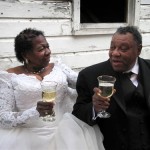 Before there was a Memorial Day, there was Decoration Day. Developed in the Post-Civil War decades, Decoration Day was exactly that: A day to decorate the graves of fallen soldiers. Over time, and with the sacrifice of so many young men and women in two World Wars, the name was changed, and Memorial Day became an official US holiday.
Before there was a Memorial Day, there was Decoration Day. Developed in the Post-Civil War decades, Decoration Day was exactly that: A day to decorate the graves of fallen soldiers. Over time, and with the sacrifice of so many young men and women in two World Wars, the name was changed, and Memorial Day became an official US holiday.
Decoration Day still persists, however, as a way of honoring not only those who died in war, but all the beloved dead of the past. On some weekend between May and September – local tradition usually determines the date – families all over the mountain south show up at their ancestors’ graves.
They cut the grass and trim the weeds around the burial stones. They throw away the old, faded flowers, pick up tree limbs, and complete any necessary repairs. All this work is usually done on Saturday, and then on Sunday the living descendants of the dead return to the recently cleaned cemetery with freshly cut roses, potted plants, and silk flower arrangements to decorate the graves.
This affair usually involves a sermon or a memorial service, a few old hymns like “That Glad Reunion Day,” and this is followed by a massive dinner on the grounds. Stories of the old saints gone by are told, new babies and grandchildren are presented, and an impromptu family reunion ensues.
A product of the southern Appalachians, I have some firsthand experience with Decoration Day. So does my wife. Every July she finds herself neck-deep in grave stones with her mountain mama at the Zion Church Cemetery on Snake Nation Road, Blue Ridge, Georgia, pruning hedgerows and running a weed trimmer (her father usually stays away – he’s from New Jersey and never really got into mountain culture anyway).
On one hand, Decoration Day is very practical. Someone has to care for the burial grounds. But on the other hand, Decoration Day is also very social. It scratches a nostalgic itch. It connects people with their past, where they came from, it brings families back together, and kindles some old, good memories.
Personally, I love the ancestor stuff, old gospel songs, and dinner on the grounds; but I don’t like Decoration Day among the tombs. It’s because there are always one or two crazy relatives at the event that make the whole thing unbearable. Granted, we all have those nutty aunts, cousins, and in-laws that hang on the family tree. But that’s not the unbearable quality of which I’m speaking.
It’s those people who live for this event in the cemetery. They love, not remembering and honoring the past, but living in the past. Everything about their life is an effort to go backward. They are more at home among the graves of yesterday than the celebrations of today; and they have become as dead as the granite headstones around which they hover.
Certainly it’s easy to get trapped in the boneyard of the past. The death of a partner, bad choices we have made, ways we have been harmed or how we have harmed others, the heartbreaking losses of love and life, numerous self-inflicted wounds: There is no magical whitewash for our past and no tiny recessed button in the back of our skulls to reset our memory banks.
No, we can’t forget about the past if forgetting means acquiring a blessed case of selective amnesia. But we can forget the past if forgetting means living in such a way that the past no longer has a totalitarian control over us. Properly forgetting the past is not an act of erasing our memories; properly forgetting is an act of defiance, whereby we keep living and keep going.
Properly forgetting is when we rightly remember and honor the burial of yesterday, but we absolutely refuse to waste today by living in the graveyard. So when it comes to our past, let’s put it in its place. Remember it. Honor it. Mourn it and celebrate it. But then let’s get on with it, because life is moving forward with or without us.
Ronnie McBrayer is a syndicated columnist, speaker, and author of multiple books. You can read more and receive regular e-columns in your inbox at www.ronniemcbrayer.net.

